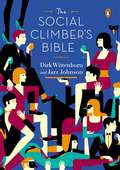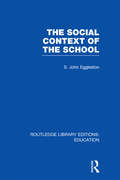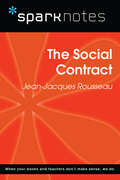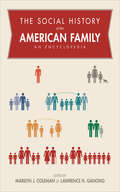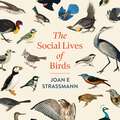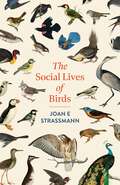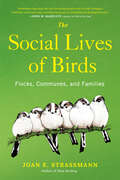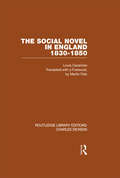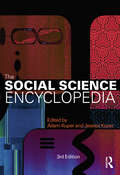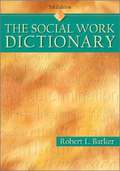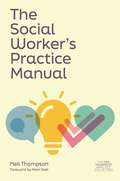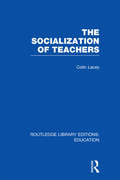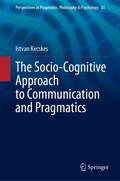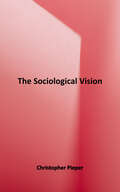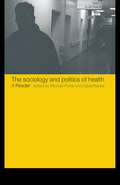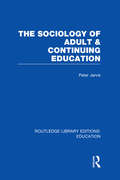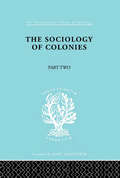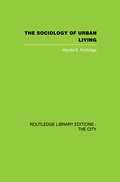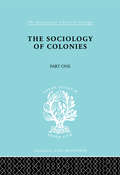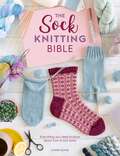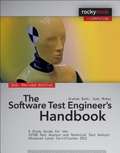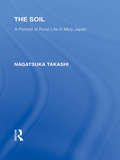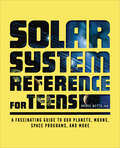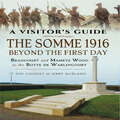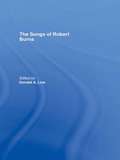- Table View
- List View
The Social Climber's Bible
by Dirk Wittenborn Jazz JohnsonWelcome fledging Social Climbers! Allow us to show you the way. Birds do it, bees do it, even educated fleas do it, so what's the big deal? You shouldn't be punished for wanting to improve your lot in life! This is America, after all. Johnson & Johnson heiress Jazz Johnson is a lifelong insider in that rarefied world that fans of both Downton Abbey and Gossip Girl dream about. Raconteur Dirk Wittenborn is old enough to remember when sex was safe and cocaine wasn't addictive. In short, Jazz belongs to some of the most exclusive clubs in the world, whereas Dirk has been kicked out of them. Who better to guide you? In the grand tradition of True Prep and The Hipster Handbook, The Social Climber's Bible will teach you everything you need to know to become a pro Mountaineer: The Art of Social Climbing at gallery openings, cocktail parties, and funerals Social Climbing as a family How to handle sex, dating, marriage, and love Your social climbing IQ and how to improve it How to spot a Big Fish, Whale, Turtle or Unicorn, and what they can do for you
The Social Context of the School (Routledge Library Editions: Education)
by John EgglestonIn their appearance, schools often seem to be physically separated from their surroundings, cut off from the neighbouring houses and streets by high walls, by playgrounds or playing fields. Within the school, another world seems to exist, with a life of its own – its own routine, dress, rules and customs – which appears to have little relationship to the day-to-day life of the society outside. Yet despite these signs of separateness, we are becoming increasingly aware that a school’s surroundings, the local society in which it is set and whose children it educates, play an important part in determining what actually goes on in the classrooms and the playgrounds. This book looks at some of the factors in the local context of the schools and describes and analyses some of the often complex ways in which the schools interact with them.
The Social Contract (SparkNotes Philosophy Guide)
by SparkNotesThe Social Contract (SparkNotes Philosophy Guide) Making the reading experience fun! SparkNotes Philosophy Guides are one-stop guides to the great works of philosophy–masterpieces that stand at the foundations of Western thought. Inside each Philosophy Guide you&’ll find insightful overviews of great philosophical works of the Western world.
The Social History of the American Family: An Encyclopedia
by Professor Marilyn Coleman Lawrence H. GanongThe American family has come a long way from the days of the idealized family portrayed in iconic television shows of the 1950s and 1960s. The four volumes of The Social History of the American Family explore the vital role of the family as the fundamental social unit across the span of American history. Experiences of family life shape so much of an individual’s development and identity, yet the patterns of family structure, family life, and family transition vary across time, space, and socioeconomic contexts. Both the definition of who or what counts as family and representations of the “ideal” family have changed over time to reflect changing mores, changing living standards and lifestyles, and increased levels of social heterogeneity. Available in both digital and print formats, this carefully balanced academic work chronicles the social, cultural, economic, and political aspects of American families from the colonial period to the present. Key themes include families and culture (including mass media), families and religion, families and the economy, families and social issues, families and social stratification and conflict, family structures (including marriage and divorce, gender roles, parenting and children, and mixed and non-modal family forms), and family law and policy. Features: Approximately 600 articles, richly illustrated with historical photographs and color photos in the digital edition, provide historical context for students. A collection of primary source documents demonstrate themes across time. The signed articles, with cross references and Further Readings, are accompanied by a Reader’s Guide, Chronology of American Families, Resource Guide, Glossary, and thorough index. The Social History of the American Family is an ideal reference for students and researchers who want to explore political and social debates about the importance of the family and its evolving constructions.
The Social Lives of Birds
by Joan E. Strassmann'A tour-de-force survey of how birds live their lives - with all the drama, surprise, humour, sadness and amazement of any human soap-opera' - Stephen Moss, author of Ten Birds That Changed the World'Utterly fascinating . . . Strassmann is the perfect guide to this world: an author as much fascinated by the science and research as she is motivated by the sheer joy and wonder of the birds themselves' - James Macdonald Lockhart, author of RaptorIn The Social Lives of Birds, evolutionary biologist Joan Strassmann examines what it means for birds of a feather to flock together. Some birds sleep together. Some join the foraging groups of other species. Some are only social during the breeding season, forming nesting colonies in trees, cliffs, and sandbanks. Some are altruistic, helping to rear young that are not their own. Some males perform mating dances together.Strassmann explains how flocks provide safety in numbers, roosts offer warmth and shelter, and colonies allow for protected breeding. But group behavior is not without its costs-including increased competition, infidelities, tick infestations, and more. Strassmann exposes the conflicts birds face and the many ways in which they resolve these conflicts. With stories of birds from around the world-from broad-winged hawks that migrate south together in the fall, tree swallows that roost together in the thousands, and tropical anis that nest in communes-The Social Lives of Birds explores the different kinds of bird groups and what to look for when watching them. Above all, it reveals that solitary life, it seems, is not for the birds.'Delightful and informative' - Lee Dugatkin, author of How to Tame a Fox (and Build a Dog)
The Social Lives of Birds
by Joan E. Strassmann'A tour-de-force survey of how birds live their lives - with all the drama, surprise, humour, sadness and amazement of any human soap-opera' - Stephen Moss, author of Ten Birds That Changed the World'Utterly fascinating . . . Strassmann is the perfect guide to this world: an author as much fascinated by the science and research as she is motivated by the sheer joy and wonder of the birds themselves' - James Macdonald Lockhart, author of RaptorIn The Social Lives of Birds, evolutionary biologist Joan Strassmann examines what it means for birds of a feather to flock together. Some birds sleep together. Some join the foraging groups of other species. Some are only social during the breeding season, forming nesting colonies in trees, cliffs, and sandbanks. Some are altruistic, helping to rear young that are not their own. Some males perform mating dances together.Strassmann explains how flocks provide safety in numbers, roosts offer warmth and shelter, and colonies allow for protected breeding. But group behavior is not without its costs-including increased competition, infidelities, tick infestations, and more. Strassmann exposes the conflicts birds face and the many ways in which they resolve these conflicts. With stories of birds from around the world-from broad-winged hawks that migrate south together in the fall, tree swallows that roost together in the thousands, and tropical anis that nest in communes-The Social Lives of Birds explores the different kinds of bird groups and what to look for when watching them. Above all, it reveals that solitary life, it seems, is not for the birds.'Delightful and informative' - Lee Dugatkin, author of How to Tame a Fox (and Build a Dog)
The Social Lives of Birds: Flocks, Communes, and Families
by Joan E. StrassmannAn exploration of all the ways in which birds are social creatures—from breeding to nesting to babysittingIn The Social Lives of Birds, evolutionary biologist and author of Slow Birding Joan Strassmann examines what it means for birds of a feather to flock together. Some birds sleep together. Some join the foraging groups of other species. Some are only social during breeding season, forming nesting colonies in trees, cliffs, and sandbanks. Some are altruistic, helping to rear young that are not their own. Some males perform mating dances together.Strassmann explains how flocks provide safety in numbers, roosts offer warmth and shelter, and colonies allow for protected breeding. But group behavior is not without its costs—including increased competition, tick infestations, and more. Strassmann exposes the conflicts birds face and the many ways in which they resolve these conflicts. With stories of birds from around the world—from broad-winged hawks that migrate south together in the fall, tree swallows that roost together in the thousands, and guira cuckoos that nest in communes—The Social Lives of Birds explores the different kinds of bird groups and what to look for when watching them. Above all, it reveals this fact: solitary life, it seems, is not for the birds.
The Social Novel in England 1830-1850: Routledge Library Editions: Charles Dickens Volume 2 (Routledge Library Editions: Charles Dickens #Vol. 2)
by Louis CazamianThis is the first English translation of Le Roman social en Angleterre by Louis Cazamian, which is widely recognized as the classic survey of Victorian social fiction. Starting from the eighteenth century, Cazamian traces the ways in which rationalism and romanticism intertwined and competed, particularly in relation to radical political philosophy. He shows how industrialization polarized England, setting the industrial bourgeoisie in the van of progress in the first decades of the nineteenth century, until their political and economic triumph stirred up a passionate reaction against them. This reaction propelled novelists such as Charles Dickens who lies at the centre of his discussion. For this translation Martin Fido has provided a substantial foreword, and has revised and completed the bibliographical references and corrected the footnotes to assist the present-day reader.
The Social Science Encyclopedia
by Adam Kuper Jessica KuperThe Social Science Encyclopedia, first published in 1985 to acclaim from social scientists, librarians and students, was thoroughly revised in 1996, when reviewers began to describe it as a classic. This third edition has been radically recast. Over half the entries are new or have been entirely rewritten, and most of the balance have been substantially revised.Written by an international team of contributors, the Encyclopedia offers a global perspective on key issues within the social sciences. Some 500 entries cover a variety of enduring and newly vital areas of study and research methods. Experts review theoretical debates from neo-evolutionism and rational choice theory to poststructuralism, and address the great questions that cut across the social sciences. What is the influence of genes on behaviour? What is the nature of consciousness and cognition? What are the causes of poverty and wealth? What are the roots of conflict, wars, revolutions and genocidal violence?This authoritative reference work is aimed at anyone with a serious interest in contemporary academic thinking about the individual in society.
The Social Work Dictionary (5th Edition)
by Robert L. BarkerProvides the social worker with an abbreviated interpretation of the words, concepts, organizations, historical events, and values that are relevant to the profession. Covers some 8,000 terms, including 2,000 that are new to this edition. Other features include a list of frequently-used acronyms; a list of milestones in the development of social work and social welfare; the NASW Code of Ethics; and resources. Annotation copyrighted by Book News, Inc., Portland, OR.
The Social Worker's Practice Manual (The Neil Thompson Practice Collection)
by Neil ThompsonAn essential handbook for students and experienced social workers alike, this practical guide filters out the jargon and sets out what you really need to know. 30 easy-to-follow chapters delve into topics ranging from holistic thinking to effective record keeping, all rooted in Neil Thompson's extensive hands-on experience. Complicated subjects such as cultural sensitivity and managing conflict are discussed thoughtfully and pragmatically, helping you understand the roots of tricky situations and find effective solutions. Each section successfully combines theory and practice to give a holistic view of social work that can be tailored to help each unique client. Over 45 years of experience distilled into one manual for success.
The Socialization of Teachers (Routledge Library Editions: Education)
by Colin LaceyThe change from a student role to a teacher role can be one of the most abrupt and stressful transitions in working life but the process of socialization does not end when the student becomes a fully qualified teacher, as many writers, laymen and sociologists, would have us believe. Colin Lacey argues that socialization is a partial and rarely homogenous process. He illustrates this from a wide variety of interesting case material to show how student teachers adapt their responses to the classroom situation.
The Socio-Cognitive Approach to Communication and Pragmatics (Perspectives in Pragmatics, Philosophy & Psychology #33)
by Istvan KecskesThe book aims to serve as a theoretical framework for the socio-cognitive approach (SCA) that is an alternative to the two main lines of pragmatics research: linguistic-philosophical pragmatics and sociocultural-interactional pragmatics. SCA broadens the scope of the field with an intent to incorporate not only L1 communication but also intercultural communication, and communication in a second language. The author integrates the pragmatic view of cooperation and the cognitive view of egocentrism and emphasizes that both cooperation and egocentrism are manifested in all phases of communication, albeit to varying extents. SCA places equal importance on the social and cognitive individual factors in pragmatics. The author claims that while (social) cooperation is an intention-directed practice that is governed by relevance, (individual) egocentrism is an attention-oriented trait dominated by salience.The book serves as a theoretical guide for researchers and students who would like to understand how we need to change first language-based theories to make sense of what happens not only in L1 but also in intercultural and multi-lingual interactions.
The Sociological Vision
by Christopher PieperNew Edition Now Available! What is sociology? Will I like it? Does it matter in the world? Can it help me? The Sociological Vision is designed to answer these questions and cultivate a new way of seeing social life. Geared primarily toward students beginning a journey into the social sciences, or for those with general curiosity for the subject, The Sociological Vision offers a glimpse into the fascinating, revelatory, and occasionally fun world of sociology. Consider it a " sampler platter" for studying human societies and cultures. The book uses a historical approach, a comparative glance, and a critical eye. It shows students how to hone the skills we all have as "armchair" sociologists in observing, describing, explaining, and evaluating the social world in more systematic ways. It encourages readers to ask tough questions about society and themselves. The book emphasizes the individual's role as both participant in society and a recipient of societal influences. Finally, it focuses on how we each build the social order and considers the larger impacts of these small actions.
The Sociology and Politics of Health: A Reader
by David Banks Michael PurdyHealth care systems, the role of health professionals and the experience of health and illness are all undergoing change and development as we enter the twenty-first century. The Sociology and Politics of Health is a collection of key readings through which to explore the sociological and political dimensions of health, illness and health care. Combining classic pieces with more up-to-date contributions, it includes examples taken from current domestic and international initiatives and draws on humanist, materialist, feminist and constructionalist perspectives. The Sociology and Politics of Health covers: * ideology and policy * social stratification * professionalisation * the experience of health and illness. * This reader offers health studies students, nurses and other health professionals an invaluable introduction to an increasingly important field of social inquiry.
The Sociology of Adult & Continuing Education (Routledge Library Editions: Education)
by Peter JarvisThis book provides a comprehensive sociological overview of adult and continuing education. It draws on all branches of sociology rather than advocating one approach. It examines the theories of all the significant sociological writers in the field such as Knowles, Marx, Freire and Gramsci and sets them in the broader intellectual context. It also considers the content of the curriculum in adult education and the place of adult education in society at large. The author indicates the strengths and weaknesses of the different sociological perspectives and demonstrates how they can be used to analyse the function and purpose of adult and continuing education.
The Sociology of Colonies [Part 2]: An Introduction to the Study of Race Contact (International Library of Sociology)
by Rene MaunierFirst published in 1998. Routledge is an imprint of Taylor & Francis, an informa company.
The Sociology of Urban Living
by Harold E. NottridgeThe urban setting in which people live has an important influence upon the organization and planning of their social lives. H. E. Nottridge here presents a valuable introduction to the field of urban sociology, showing that it is a theoretical discipline which is worthy of consideration in its own right. Throughout his account Mr Nottridge places strong emphasis on the need for comparative perspectives. He uses a wide range of source material from urban environments as far apart as shanty towns in developing countries and the great metropolitan complexity of London. He covers such topics as scope and methods in urban sociology, social differences in towns and , in the context of urban social structure, the family and network theories. He also analyses the work of the Chicago School of Weber, Tonnies, Park, Redfield and Wirth, assessing their value for mdoern urban sociology. The author concludes with an examination of housing, migration and urban poverty. This book was first published in 1972.
The Sociology of the Colonies [Part 1]: An Introduction to the Study of Race Contact (International Library of Sociology)
by Rene MaunierFirst published in 1998. Routledge is an imprint of Taylor & Francis, an informa company.
The Sock Knitting Bible: Everything you need to know about how to knit socks
by Lynne RoweThe definitive guide to knitting cozy, colorful socks, covering every aspect for knitters of all abilities.The Sock Knitting Bible is the ultimate reference for sock knitting skills, techniques, materials, projects, and more. Here you'll find in-depth information on everything from sizing and yarn to casting on and color-work. Whether you want to knit toe up, cuff down or even two at a time socks, this comprehensive volume covers it all.There are step-by-step instructions for all the various sock knitting techniques, as well as three basic sock patterns that even an absolute beginner can follow. Author Lynne Rowe also looks at the different kinds of tools available, from double pointed needles and small circular needles to innovative products such as flexible DPNs.And it all comes together with ten delightful projects by some of the most exciting and talented sock designers. Here you will find patterns for stripes, fair isle, cables, lacy, sparkly and snuggly socks: an array o pattern for all your sock-knitting needs!
The Software Test Engineer's Handbook
by Judy Mckay Graham BathRevised and updated 1st Edition, 2011 There are a lot of books around covering functional testing techniques, but relatively few cover both functional and technical testing. This book will fill that gap. Authors Graham Bath and Judy McKay are core members of the ISTQB Working Party that created the new advanced level syllabus, which will be rolled out worldwide this year. This book brings both functional and technical aspects of testing into a coherent whole, which will benefit not only test analyst/engineers but also test managers. Based on the "Certified Tester" Advanced-Level syllabus issued by the ISTQB in 2007, the book covers everything you will need to know to successfully sit the examinations for Test Analyst and Technical Test Analyst. For those planning to take one or both of these exams, the book provides a solid base for preparation and clearly indicates which sections apply to which specific examination.
The Soil: A Portrait of Rural Life in Meiji Japan (Routledge Library Editions: Japan)
by Nagatsuka TakashiThis is a selection of the best plays of Chikamatsu, one of the greatest Japanese dramatists. Master of the marionette and popular dramas, he had, until the publication of this book, remained unknown to western readers owing to the difficulty of translating the work into English. The introduction provides a comprehensive survey of the history of Japanese drama which will assist the reader in better understanding the plays.
The Solar System Reference for Teens: A Fascinating Guide to Our Planets, Moons, Space Programs, and More
by Dr. Bruce BettsTake a tour of our solar system with this guide for teens ages 12 to 16 From the moons of Jupiter to the surface of Mars, our solar system is home to a multitude of wild, weird worlds. Crack open this solar system book and embark on a journey through space as you meet key figures in history, explore careers in astronomy, uncover some of the solar system's biggest mysteries, and more. Tons of images—Bring celestial objects into focus through more than 160 images, illustrations, and diagrams that provide a close-up look into our solar system and how it works. Fascinating facts—Did you know the Moon gets farther from Earth each year at about the same rate that your fingernails grow? Discover all sorts of awe-inspiring facts about our solar system's planets, moons, and more. Exciting exploration—Learn about important historical achievements and technological developments—including missions to different parts of the solar system—and get tips for your own stargazing sessions. Explore all the cool stuff in our solar system with this accessible reference guide for teens.
The Somme 1916—Beyond the First Day: Beaucourt and Mametz Wood to the Butte de Warlencourt (A Visitor's Guide)
by Jon Cooksey Jerry MurlandIn their second Visitor’s Guide to the 1916 Battle of the Somme Jon Cooksey and Jerry Murland focus on the series of secondary battles that were key stages in the five-month struggle that followed the start of the offensive on 1 July. They take the visitor – and the reader – across the entire battlefield, covering in graphic detail sites where actions took place that are almost as famous as the Somme itself in the history of the First World War, including Mametz Wood, High Wood, Deville Wood, Guillemont, Ginchy, Pozieres and Flers. They also provide tours of the less-well-known but equally interesting sites which played important parts in the offensive as a whole. In a sequence of routes that can be walked, biked or driven they describe what happened in each place, identify the units involved, highlight the experience and exploits of individual soldiers, and point out the notable sights, monuments and cemeteries. This highly illustrated guidebook is essential reading for visitors who wish to enhance their understanding of the Battle of the Somme and the war on the Western Front. It is also the ideal companion volume to The First Day of the Somme: Gommecourt to Maricourt by the same authors.
The Songs of Robert Burns
by Donald A. LowIn this definitive work for our generation, Donald Low brings together, for the first time, the words and tunes of all Burns' known songs, both `polite' and bawdy. The Songs of Robert Burns were, in their author's eyes, the crown of his achievement as a poet. After years of study and investigation, many hours spent listening to old airs, as he recalled the living, daily, song-life of the people of Scotland, and through the creation of some of the finest lyric poetry produced in the British Isles, Burns' success is beyond doubt.
